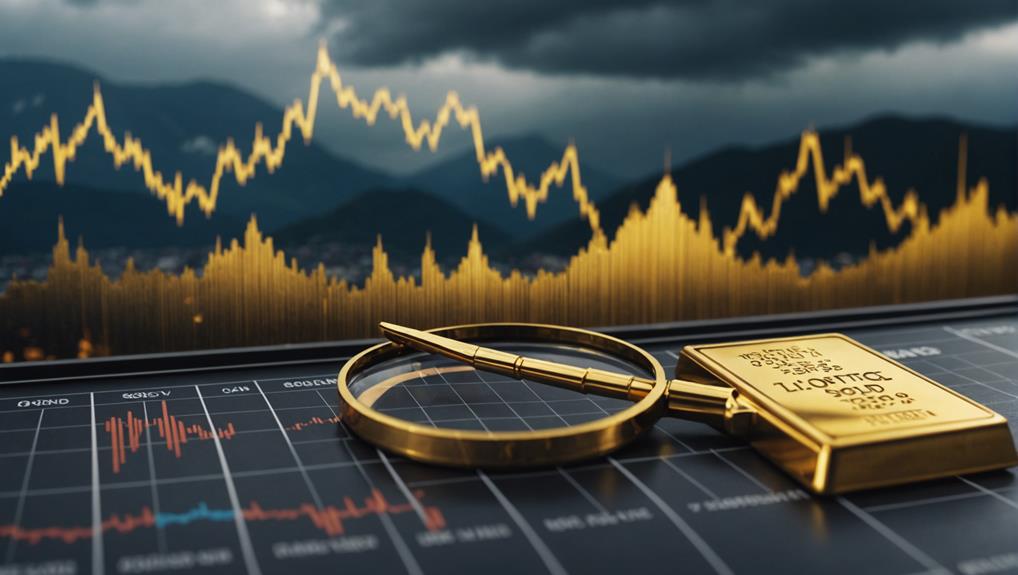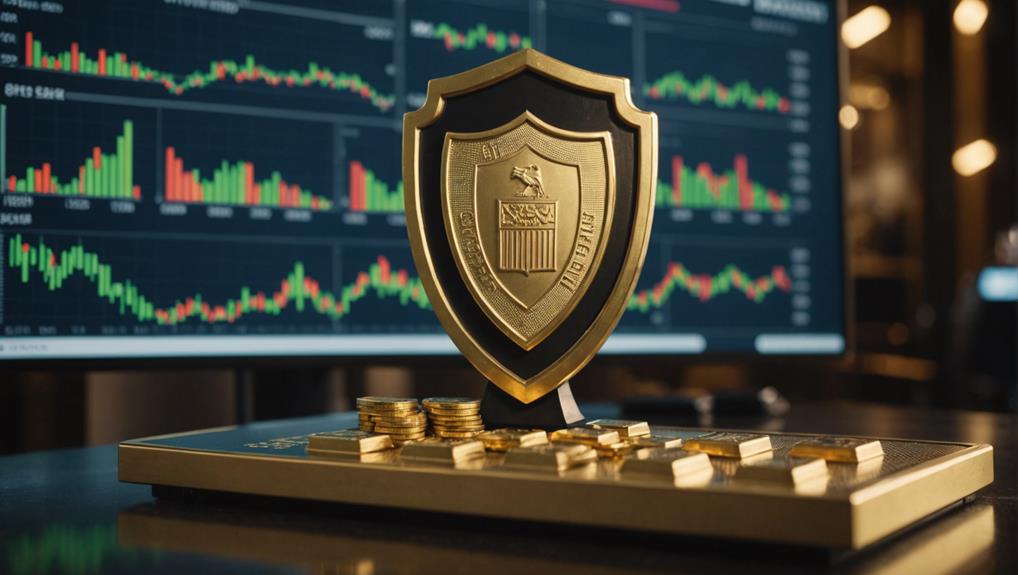Investing in gold futures involves a complex landscape where potential gains come hand in hand with significant risks. Factors like leverage and margin requirements can magnify profits or losses, necessitating careful consideration.
The inherent price volatility of gold, influenced by various economic and geopolitical events, demands continuous monitoring. Moreover, systemic failure risks and the broader economic implications on the gold futures market add further layers of complexity.
To navigate these challenges effectively, traders must develop robust risk management strategies. How can traders safeguard their investments amidst these intricacies?
Key Insights
- Leverage in gold futures amplifies both potential profits and risks, requiring careful risk management.
- Gold futures trading involves price volatility influenced by economic, geopolitical, and market factors.
- Meeting margin requirements is crucial to avoid margin calls and forced liquidations.
- Effective risk management strategies, including stop-loss orders and diversification, are essential.
- The lack of physical gold ownership exposes traders solely to market risks and uncertainties.
Basics of Gold Futures Trading

Gold futures trading involves participating in standardized contracts on exchanges to buy or sell a specified amount of gold at a predetermined price and date. These contracts offer investors the opportunity to benefit from price movements without the need to own physical gold, providing both flexibility and liquidity.
Commodity brokers play a crucial role in facilitating the trading process, assisting investors in navigating the complexities of the market. Understanding margin requirements is essential in gold futures trading, as it represents the minimum funds required in an account to initiate a trade, ensuring traders have adequate capital to cover potential losses.
Gold futures serve various purposes, including hedging against price risks, engaging in speculation, and diversifying investment portfolios, making them a versatile tool for a wide range of market participants.
Leverage and Margin Requirements
Leverage in gold futures trading allows investors to amplify their profit potential, but it also enhances the risk of significant losses.
Meeting margin requirements is vital for entering and maintaining positions, and failure to do so can result in margin calls, particularly during market volatility.
Understanding the capital needed and implementing proper risk management strategies is fundamental to navigating these risks effectively.
Amplified Profit Potential
Traders are often drawn to gold futures due to the potential for amplified profits through leverage, which allows for controlling larger positions with smaller initial investments. Leverage magnifies both gains and losses, underscoring the necessity of effective risk management.
Margin requirements, the essential funds for opening and maintaining a position, directly impact the available level of leverage. Understanding these requirements is crucial for traders seeking to balance potential returns with inherent risks.
Margin Call Risks
Gold futures margin call risks result from the potential decline in the value of leveraged positions, necessitating additional funds to cover potential losses. Leveraging in futures trading enables traders to control larger positions with a smaller initial investment, amplifying both potential gains and risks.
Margin requirements stipulate the minimum funds that must be maintained in trading accounts. If the value of a gold futures contract moves unfavorably, traders may encounter margin calls, prompting the need for additional deposits to support their positions. Failure to meet these margin requirements can lead to brokers forcibly liquidating positions to mitigate risks.
Understanding margin call risks is essential for effectively managing leverage and ensuring adequate account funds in the dynamic futures trading landscape.
Capital Requirement Details
Gold futures trading entails specific margin requirements, defining the minimum capital necessary to uphold positions.
Traders typically need to deposit a margin, a fraction of the contract value, enabling them to control larger positions with less capital. This leverage can enhance potential profits but also escalates the risk of losses in adverse market movements.
Margin requirements fluctuate based on contract size, volatility, and market conditions, influencing the required capital. Traders must uphold a minimum margin balance to avoid margin calls, necessitating additional funds to cover potential losses.
Comprehending leverage and margin requirements is crucial for effectively managing these risks.
Price Volatility Risks

To navigate the price volatility inherent in gold futures trading, investors must possess a thorough understanding of the economic, geopolitical, and market factors that drive rapid price fluctuations. The risks associated with price swings are a primary concern for investors, as they can swiftly impact investment returns.
Implementing effective risk management strategies is essential to mitigate these risks. Techniques such as utilizing stop-loss orders and diversifying portfolios can help in safeguarding investments from sudden price changes.
Keeping abreast of market developments, including shifts in economic conditions and geopolitical events, is crucial for anticipating potential price movements. Analyzing historical price data and market trends can provide valuable insights into future price fluctuation patterns.
Systemic Failure Risks
Gold futures trading carries systemic failure risks that can result in financial system collapses due to interconnected market disruptions, liquidity crises, or widespread defaults. These risks materialize when failures in the financial system trigger a chain reaction, impacting gold futures contracts.
For instance, a liquidity crisis may lead to traders failing to meet margin calls, causing widespread defaults that disrupt the market. Such systemic failures can result in substantial losses for investors, underscoring the importance of understanding and managing these risks.
To safeguard portfolios when investing in gold futures, investors must be vigilant about these potential threats and implement effective risk management strategies to mitigate their impact.
Economic Impact on Gold Futures

The economic landscape profoundly influences gold futures, with inflation and interest rates playing crucial roles in their pricing.
Geopolitical events can also cause significant fluctuations, as investors often seek gold as a safe-haven asset during times of uncertainty.
Moreover, the strength of currencies and central bank policies further impact gold's performance, requiring a thorough understanding of these factors for effective trading strategies.
Inflation and Interest Rates
Gold futures markets are intricately influenced by inflation and interest rates. In times of rising inflation, gold is sought after as a hedge against diminishing currency value, leading to heightened demand for gold futures.
Low interest rates tend to drive up gold prices, as the opportunity cost of holding non-interest-bearing assets like gold decreases. A dovish monetary policy, characterized by lower interest rates, can further push gold prices upwards.
The uncertainty brought about by fluctuations in inflation and interest rates can significantly increase volatility in gold futures markets, necessitating careful consideration from investors.
Geopolitical Events Influence
Gold futures markets are undoubtedly influenced by inflation and interest rates, but the impact of geopolitical events on gold prices is equally significant. Geopolitical risk, ranging from trade disputes to wars and political instability, introduces substantial economic uncertainties.
In response, investors often turn to safe-haven assets like gold futures, recognizing gold's stability and value preservation qualities. The heightened demand for gold futures during geopolitical crises reflects investors' inclination to hedge against such risks.
Additionally, geopolitical events can cause fluctuations in global markets and currencies, directly affecting gold futures prices. This dynamic underscores the strategic importance of gold reserves and reinforces gold's reputation as a reliable hedge in times of global turmoil.
The close relationship between geopolitics and gold futures underscores the asset's enduring relevance in uncertain times.
Currency Strength Impact
Gold futures prices are significantly influenced by currency strength, with a weaker currency typically resulting in higher gold values. As the U.S. dollar index (DXY) declines, currency devaluation often occurs, making gold a more appealing investment option. The Federal Reserve (Fed) plays a key role in influencing currency strength through its monetary policies, which in turn indirectly impacts the gold futures market.
Currency devaluation: Gold serves as a hedge during periods of currency devaluation.
Economic uncertainty: Investors turn to gold futures as a safe haven in times of economic instability.
Inflation: Changes in inflation levels can affect currency strength and increase the attractiveness of gold.
U.S. dollar index (DXY): A lower DXY indicates a stronger gold market.
Federal Reserve (Fed): Policy decisions by the Fed can lead to currency fluctuations, thereby influencing gold prices.
Gold Futures Vs. Other Investments
Comparing gold futures to other investment options reveals distinct advantages, including leverage and the opportunity to profit from price fluctuations without the need to physically hold the metal. Futures contracts offer a structured approach to participating in gold trading, allowing investors to amplify their potential gains with minimal capital investment.
In contrast to exchange-traded funds (ETFs) or gold mining stocks, gold futures provide direct exposure to gold price movements at a lower cost. While ETFs offer diversification and liquidity, and gold mining stocks may yield dividends and growth, they also entail company-specific risks.
Each type of investment carries its own set of risks and rewards, underscoring the importance for investors to align their choices with their financial objectives and risk tolerance levels.
Risk Management Strategies

Effective risk management in gold futures trading is crucial to safeguarding investments and achieving long-term success.
Strategies such as spreading investments across various gold futures contracts and using hedging methods can reduce risks associated with market volatility.
Moreover, understanding and applying these techniques helps traders protect their portfolios from unfavorable price movements in the gold market.
Diversification Techniques
Diversification in gold futures trading is a strategic approach where investments are spread across multiple contracts and asset categories to reduce risk. By diversifying, traders can effectively manage risk and protect their portfolios from unfavorable price fluctuations, ultimately aiming for a more stable return on investment.
Key strategies for diversification include:
- Investing in a variety of gold futures contracts.
- Incorporating other assets like stocks or bonds in the portfolio.
- Applying position sizing based on account size and risk tolerance.
- Conducting thorough research and education to make well-informed decisions.
- Maintaining disciplined trading plans to ensure consistent strategies.
These methods collectively enhance risk management, which is essential for navigating the volatile nature of gold futures trading.
Hedging Methods
Gold futures hedging involves using contracts strategically to manage risks associated with price fluctuations in the physical gold market. By utilizing gold futures, investors can secure prices to protect themselves from adverse market movements, effectively managing price volatility and uncertainty.
Traders can employ different strategies, such as taking long or short positions, to hedge against potential price changes and enhance risk management. This approach helps investors better control their exposure to price risks by locking in future prices through contracts, thereby reducing potential losses and potentially securing profits in volatile markets.
Benefits of Gold Futures
Investing in gold futures offers numerous advantages, providing investors with greater control over a larger gold quantity with a minimal capital requirement. This financial tool enables speculation on price movements without the necessity of owning physical gold, allowing for potential profit opportunities.
Additionally, gold futures serve as a valuable asset for diversifying investment portfolios, offering a means to balance and enhance overall financial strategies. Furthermore, they act as a hedge against economic uncertainties and inflation, safeguarding investments in times of market volatility.
The ease of cash settlement simplifies entry and exit from positions, ensuring convenient management of investments. Overall, these benefits position gold futures as a versatile option for a variety of investment approaches.
Drawbacks of Gold Futures

Trading gold futures involves high leverage, which can significantly magnify potential losses, making it a risky endeavor. While the potential for large gains exists, the flip side is substantial losses that may necessitate meeting margin calls to cover deficits.
Additionally, the time-sensitive nature of gold futures, with expiration dates requiring vigilant monitoring and active management, adds another layer of complexity. The inherent volatility in gold prices can result in sharp fluctuations, further heightening the risk for traders.
Unlike owning physical gold, futures contracts do not provide ownership of the physical asset, leaving traders exposed solely to market risks. These factors collectively contribute to the intricate and risky nature of gold futures as an investment option that demands careful consideration and adept management.
Individual Goals and Risk Tolerance
Understanding your financial goals and risk tolerance is crucial before considering an investment in gold futures. It is essential to evaluate your investment horizon, financial stability, and ability to withstand potential losses. Gold futures can be highly volatile, necessitating a clear understanding of your risk appetite and long-term investment objectives.
Key factors to consider include your:
- Investment Horizon: Determine if your goals are short-term or long-term.
- Financial Stability: Assess your capacity to handle financial setbacks.
- Risk Appetite: Evaluate your comfort level with potential losses.
- Volatility Tolerance: Consider your readiness to manage market fluctuations.
- Investment Objectives: Ensure alignment with your overall financial strategy.
Conclusion
Investing in gold futures offers both potential rewards and notable risks, which are influenced by factors such as leverage, price volatility, and overall economic conditions.
To navigate this complex landscape, it is crucial to implement effective risk management strategies, including diversification and vigilant market monitoring.
By comprehensively understanding the nuances of gold futures trading and aligning them with individual investment objectives and risk tolerance levels, informed decision-making becomes possible.
Through thorough analysis and strategic planning, investors can not only mitigate inherent risks but also capitalize on the opportunities presented in the gold futures market.
For more information and resources on gold investments, feel free to reach out to us at:
The Gold Information Network
11900 Biscayne Blvd, Ste 127B, Miami, FL 33181
(305) 449-9094
https://goldinfo.net







